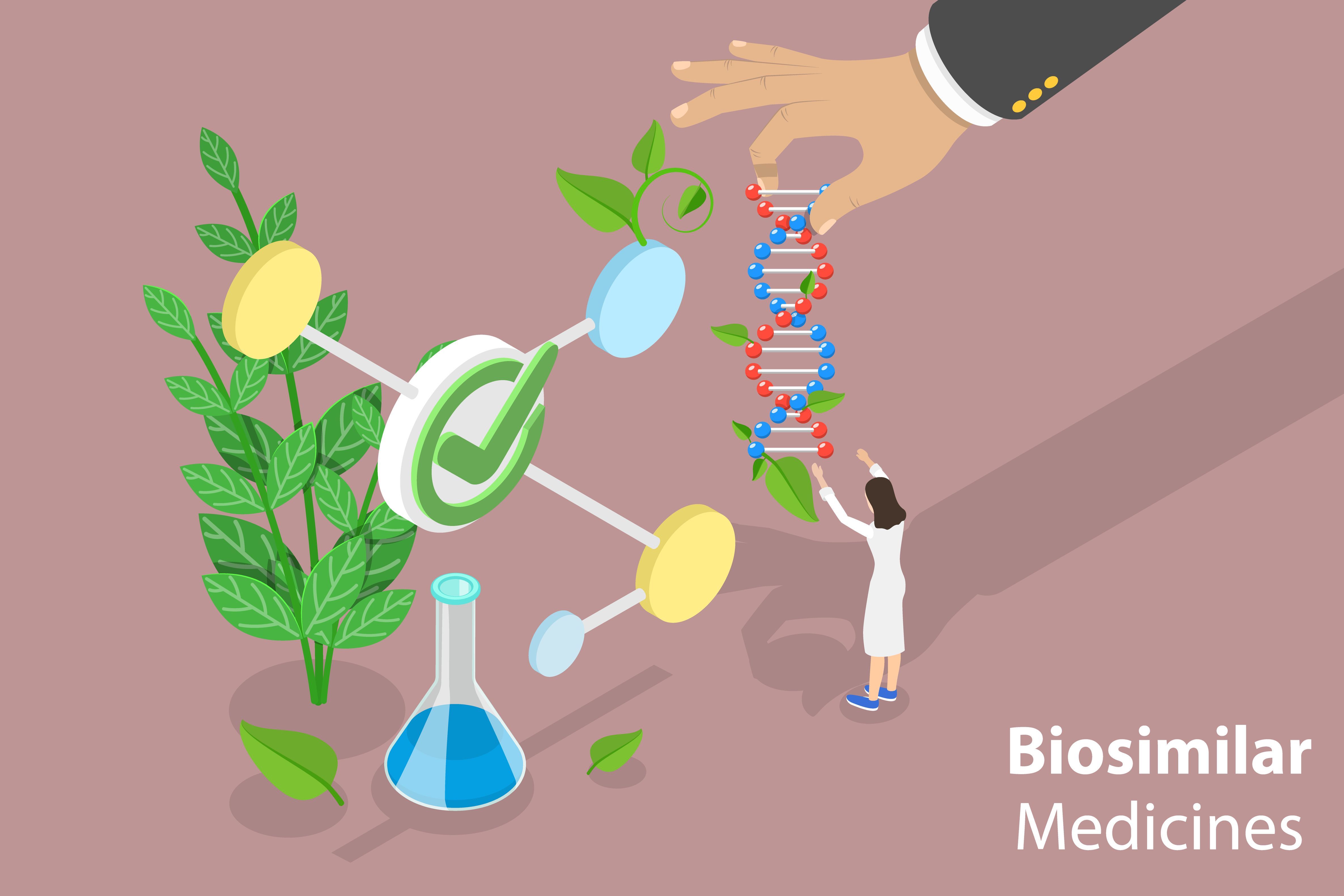- Bone Health
- Immunology
- Hematology
- Respiratory
- Dermatology
- Diabetes
- Gastroenterology
- Neurology
- Oncology
- Ophthalmology
- Rare Disease
- Rheumatology
Sintilimab, Bevacizumab Biosimilar, HAIC Improves Survival in Patients With Unresectable HCC
Positive results of sintilimab, IBI305, and hepatic arterial infusion chemotherapy (HAIC) treatment showed shrinking tumors and previously converting inoperable hepatocellular carcinoma (HCC) to resectable HCC with manageable adverse effects.
Illustration of biosimilar medicines | Image Credit: TarikVision - stock.adobe.com

The combination of sintilimab, a low dose of bevacizumab biosimilar (IBI305), and hepatic arterial infusion chemotherapy (HAIC) showed promising efficacy and safety in treating patients with unresectable hepatocellular carcinoma (HCC).
Researchers at the Tianjin Medical University Cancer Institute and Hospital in China conducted a prospective, single arm phase 2 trial.The trial involved patients with HCC who hadn't undergone any prior systemic therapy for their cancer. From May 2021 to October 2021, the enrolled patients received a combination treatment of sintilimab (200 mg), IBI305 (7.5 mg/kg), and HAIC (folinic acid, fluorouracil, oxaliplatin for 23 hours) every 3 weeks.
Primary endpoints were the objective response rate (ORR), mainly based on the pathologic results of patients after surgical treatment with the drug, and the treatment-related adverse events (TRAEs). Secondary endpoints included the event free survival (EFS), overall survival (OS), the pathological complete response (pCR) rate, and the surgical conversion rate. Researchers observed disease control in patients with partial responses (PR) and stable disease (SD).
The patients that reached conversion surgery criteria were administered another cycle of sintilimab and HAIC. Contrast-enhanced computed tomography or magnetic resonance imaging were used to assess tumors at baseline and after the third to the sixth cycle of treatment to evaluate resection probability.
A total of 30 patients were enrolled in the study with their safety outcomes analyzed. After 1 voluntarily withdraw, 29 patients completed antitumor efficacy outcomes, conversion therapy, and the tumor assessments.
Participants had a median age of 55.5 years, included 26 males (72.2%), over a 3-cycle treatment duration period. The study population consisted of 79.3% of patients with hepatitis B and 13.8% with hepatitis C. The most common observations made among patients were vascular invasion (51.7%) or extrahepatic metastasis (48.3%).
Results met the primary endpoint with 17 (58.6%) of 29 unresectable HCC patients that were assessed by an independent review committee achieved ORR. About 23 of 29 patients observed disease control with partial response (PR) in 17 (58.6%) patients and stable disease in 6 (20.7%). Following conversion treatment, a-fetoprotein levels decreased (P = .0302).
Among 20 patients, further treatment was successfully converted (69%). Although, 1 patient refused further treatment and 19 patients were included in the final count. Tumor remission status of 14 patients underwent resection, 3 underwent radiofrequency ablation, 2 underwent biopsies to compare treatment effects, and all patients achieved R0 resection. Only 1 patient (5.3%) achieved pCR and 5 patients (26.3%) reached major partial response after undergoing pathological examinations using surgical specimens or biopsy specimens.
On average, follow-up ranged over 19.3 months. The OS rate of the 29 patients after 3, 6, 9, and 12 months was 93.1%, 86.2%, 72.4%, and 65.5%, respectively. The EFS rates for 3, 6, 9, and 12 months were 89.7%, 62.1%, 44.8%, and 41.4%.
Clinical remission was achieved by 1 group of patients while another group achieved SD or PR. After 1 year, OS rates of the PR group (n =17) and PD plus SD group (n =12) were 82.4% and 41.7%. After 1 year, EFS rates of the PR group and PD plus SD group were 52.9% and 25%.
The most common TRAEs included thrombocytopenia (40%), hypertension (23.3%), leukopenia (23.3%), hypertension (10%), diarrhea (6.7%), asthenia (3.3%), and ascites (3.3%). There were no serious adverse events (AEs) detected.
Study limitations include doses of treatment because fewer AEs could have occurred with lower medication doses. As a result of AEs, patients had poor compliance with treatment.
Results suggest that sintilimab combined with bevacizumab biosimilar and HAIC could be an effective and well-tolerated treatment for patients with unresectable HCC. However, larger studies are required to solidify these findings and determine its wider use in the future.
Reference
Liu D, Mu H, Liu C, et al. Sintilimab, bevacizumab biosimilar, and HAIC for unresectable hepatocellular carcinoma conversion therapy: a prospective, single-arm phase II trial. Neoplasma. 2024;70(06):811-818. doi:10.4149/neo_2023_230806n413
How AI Can Help Address Cost-Related Nonadherence to Biologic, Biosimilar Treatment
March 9th 2025Despite saving billions, biosimilars still account for only a small share of the biologics market—what's standing in the way of broader adoption and how can artificial intelligence (AI) help change that?
Unlocking Biosimilar Potential in Specialty Pharmacies With Legislative Support, Formulary Changes
April 24th 2025Sophia Humphreys, PharmD, MHA, BCBBS, emphasized that legislative support and formulary changes are crucial for overcoming unique challenges in specialty pharmacies and driving the growth of biosimilar adoption, which has significant cost saving potential in the next decade.
Will the FTC Be More PBM-Friendly Under a Second Trump Administration?
February 23rd 2025On this episode of Not So Different, we explore the Federal Trade Commission’s (FTC) second interim report on pharmacy benefit managers (PBMs) with Joe Wisniewski from Turquoise Health, discussing key issues like preferential reimbursement, drug pricing transparency, biosimilars, shifting regulations, and how a second Trump administration could reshape PBM practices.
The Growing Impact of Biosimilars in IBD Care
April 23rd 2025Biosimilars are proving to be a game-changing solution in the fight against inflammatory bowel disease (IBD), offering a cost-effective alternative to biologics with similar efficacy and safety, while innovative drug delivery systems promise to further enhance treatment outcomes and accessibility for millions worldwide.
Eye on Pharma: Sandoz Files Antitrust Suit; Yuflyma Interchangeability; Costco’s Ustekinumab Pick
April 22nd 2025Sandoz's antitrust suit against Amgen, the FDA’s interchangeability designation for Celltrion’s adalimumab biosimilar, and the inclusion of an ustekinumab biosimilar in Costco’s prescription program highlight growing momentum to expand biosimilar access and affordability for patients with chronic inflammatory diseases.
